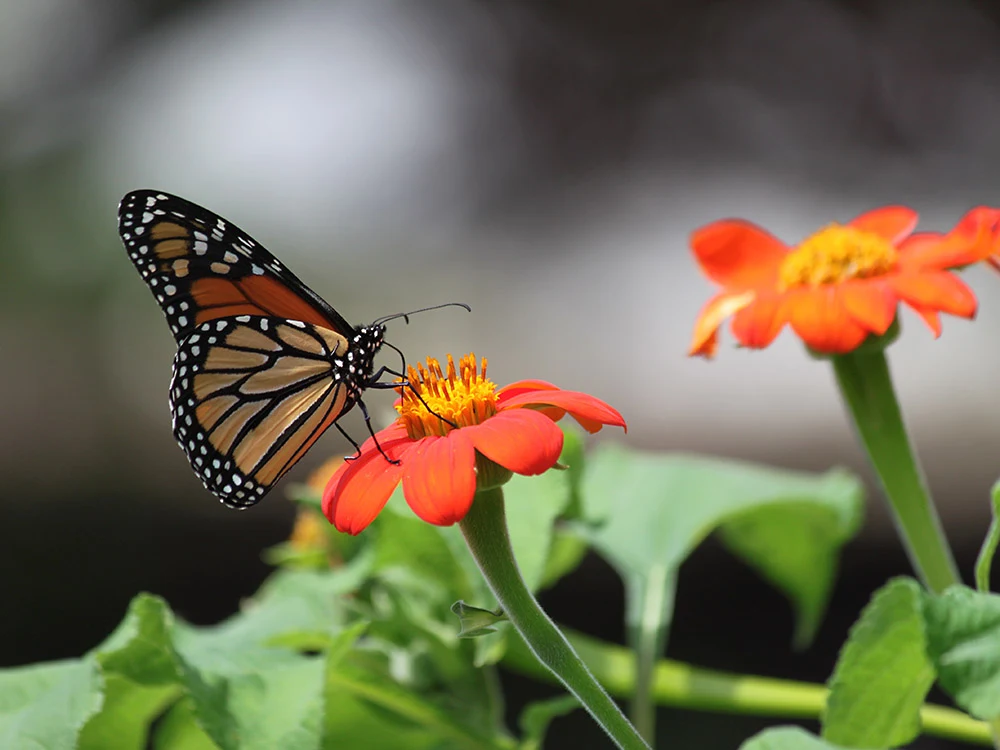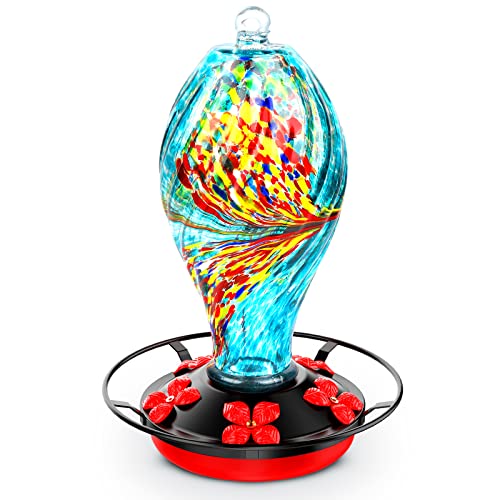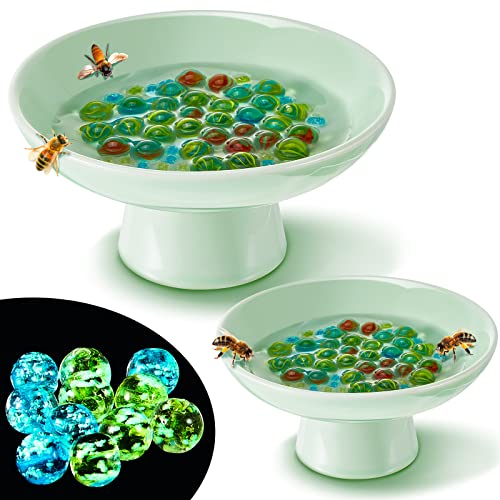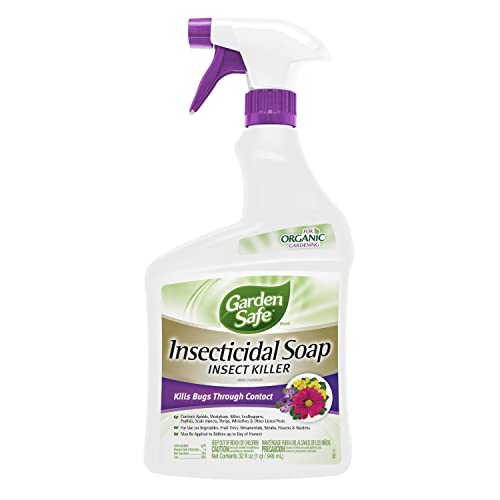Pollinator garden design ideas are hot right now, and they’re not just a feast for your eyes. These gardens serve an incredibly crucial function for our environment, too. Stick around, and you’ll learn all the whys and how-tos to make your yard the talk of the town, among bees, butterflies, and birds, that is.
Why Pollinator Gardens Matter
Environmental Benefits
Pollinators like bees and butterflies aren’t just cute; they’re outright essential. We’re talking about the unsung heroes that keep our ecosystems churning and our grocery store shelves stocked with fruits and veggies. Recognizing the importance of pollinators, by having a garden that caters to them, you help bridge the gaps in their ever-shrinking natural habitats.
Importance for Biodiversity
Think of biodiversity as nature’s safety net. The more diverse an ecosystem, the more resilient it is. So, in creating a pollinator garden, you’re not just setting up a bee buffet; you’re playing a tiny but vital role in strengthening the biodiversity of your local environment. That’s a big win for you, me, and the critters buzzing around.
Understanding the importance of these pollinators is the first step in exploring creative pollinator garden design ideas.
Planning: Pollinator Garden Design Ideas
Before diving into specific pollinator garden design ideas, it’s crucial to do some planning.
Deciding the Location
When it comes to setting up a thriving pollinator garden, location is absolutely critical. You’ll want to choose a spot that gets plenty of sunlight, ideally, at least 6 hours a day. Sunlight is like the red carpet that invites pollinators to your garden party.
But it’s not just about the sun; you also need to consider the wind. Some pollinators, especially the tiny ones, aren’t big fans of strong winds. A location that provides some natural windbreaks like fences, trees, or shrubs can be ideal. The goal is to make it as inviting as possible for your winged guests.
Size Considerations
Alright, let’s chat about size. You don’t need a sprawling estate to make a meaningful impact. In fact, a smaller space can often be more manageable and just as effective. A modest patch, say, 6×6 feet, can be a pollinator paradise if you plan it well.
The key is to maximize the types of plants you include to ensure a variety of food sources.
Now, if you’ve got the room to go big, by all means, go for it! More space means more room for a diverse range of plants, which in turn will attract a wider range of pollinators.
Seasonal Planning
You’ll want to provide something for every pollinator at any time of the year. That means planning your garden so that something is in bloom from early spring all the way to late fall. For example, crocuses can pop up in early spring, sunflowers can dominate the summer, and asters can add color in the fall.
Not just that, consider the foliage and fruit that can offer food and shelter during the winter months. Evergreens, seed pods, and even dried perennial stalks can be helpful. These are all essential seasonal considerations for pollinator gardens.
I leave the dried stalks of my summer blooms intact through the winter, and it’s amazing to see how many critters find refuge in them.
So, when planning, consider the entire calendar. Look up bloom times for different plants and arrange them in a way that offers continuous blooms. It takes a bit of planning, but the payoff is a garden that’s perpetually buzzing with life.
Types of Pollinators to Target
Knowing which pollinators you want to attract can guide your pollinator garden design ideas.
Bees (Honeybees, Native Bees)
In the quest for a pollinator-friendly garden, attracting bees is paramount, as they are among the most efficient pollinators. To lure these buzzing wonders, consider planting a range of bee-friendly flowers that bloom at different times, ensuring a consistent food supply. Native plants like milkweed, coneflower, and bee balm are excellent choices, but herbs like lavender and rosemary and even vegetable blossoms can also be bee magnets.
Plant these in sunny patches, as bees are most active in well-lit areas. Also, provide a shallow water source for them to drink from, and avoid using pesticides to maintain a haven where bees can thrive. Learn how to create a bee friendly garden.
Butterflies and Moths
To attract butterflies and moths to your pollinator-friendly garden, focus on offering a variety of nectar-rich flowers that they can’t resist. Species like butterfly bush, milkweed, and zinnias are excellent for butterflies, while moths are often drawn to night-blooming flowers such as evening primrose or jasmine.
Group the same types of plants together to create a more substantial visual cue and easier access to nectar. Providing flat stones where butterflies can bask in the sun, and setting up a mud puddle, can offer them places to rest and rehydrate. Check out our page about how to attract butterflies to your garden.
Did you know each butterfly species has specific host plants they prefer for laying their eggs?
Monarchs love milkweed, while Black Swallowtails often go for parsley. Including these plants can turn your garden into a full-service butterfly station, from caterpillar nursery to adult feeding ground!
Birds (Hummingbirds)
Creating a haven for hummingbirds in your pollinator-friendly garden involves planting nectar-rich flowers with vibrant hues, especially reds and pinks, to catch their eye. Consider tubular-shaped flowers like trumpet creeper, salvia, and honeysuckle, which are easy for hummingbirds to feed from.
These agile birds also appreciate a water feature where they can bathe and drink, such as a misting fountain or shallow birdbath. Hanging a few hummingbird feeders filled with sugar water can supplement natural nectar sources, especially during migration periods.
Position these elements in sunny, open spaces to give hummingbirds enough room to hover and dart about, maximizing their pollination potential. We have a page dedicated on how to attract hummingbirds to your yard.
And it’s not just about nectar; hummingbirds also need protein, which they get from insects and spiders. So, a well-balanced garden that attracts these other creatures will keep the hummingbirds coming back for more.
Other Beneficial Insects
Yeah, yeah, we all love the bees and the butterflies, but let’s give a shoutout to the unsung heroes like beetles and flies. Sure, they may not have the same star appeal, but these little guys are hard-working pollinators in their own right.
Beetles, for instance, are super ancient. They’re some of the oldest pollinators on the block, pollinating flowers millions of years before bees even made an appearance!
Then there are flies. Now, you might be thinking, “Flies, really?” But hoverflies and bee flies are excellent pollinators.
Your pollinator garden shouldn’t be a one-hit-wonder. Aim for a variety of plants to attract a diverse crowd of pollinators. The more, the merrier!
Essential Elements for Pollinator Garden Design Ideas
The essential elements are the building blocks of all great pollinator garden design ideas.
Types of Plants (Annuals, Perennials)
When plotting out your dream pollinator garden, you’ll want to mix it up with different types of plants that attract pollinators. Let’s break it down into two main categories: annuals and perennials.
Annuals are like the fireworks of the plant world. They burst into bloom, give it their all for a season, and then they’re done. Think zinnias, sunflowers, and marigolds. These are great because they provide a quick color splash and nectar source.
Perennials, on the other hand, are the backbone of your garden. These are the long-haul truckers, coming back year after year. They may take a bit to establish, but once they do, they’re incredibly rewarding.
So, aim for a balance. Annuals for that immediate gratification, and perennials for a gift that keeps on giving.
Water Sources
You wouldn’t throw a party and not offer drinks, right? Same goes for your pollinator garden. Providing a water source is a crucial yet often overlooked element.
It doesn’t have to be fancy. A shallow dish with some stones where they can land will do the trick. I once used a birdbath with some pebbles in it, and it became the local watering hole for bees and butterflies alike.
- Nice Combination: you will receive 2 pieces of bee watering stations, one large and one small, with 100 pieces of glass marbles and 40 pieces of glow in the dark marbles, the nice combination can meet…
For a more natural look, consider adding a small pond or a fountain. The gentle sound of flowing water adds to the overall ambiance and may attract even more wildlife. Plus, let’s face it, there’s something incredibly peaceful about the sound of water in a garden.
Shelter and Habitat
Creating shelter and habitat in your pollinator garden is like rolling out the welcome mat. Many pollinators need a place to hang their hat be it for nesting, escaping predators, or just taking a break.
For bees, consider adding a bee hotel. These can be bought or DIY’d and provide solitary bees with a place to lay their eggs.
- APPROPRIATE SIZE: The full body size is L*W*H: 6.69 x 7.67 x 11.81 inches, providing a long enough tubes in 5.9’’ length and 5/16’’ diameter for solitary native bees.
For butterflies, shrubs and tall grasses offer hiding spots and caterpillar food sources. I planted a butterfly bush in one corner, and it’s like a summer resort for the monarchs.
And don’t forget about the birds. Dense shrubs can provide nesting sites and refuge from predators.
Pollinator Garden Design Ideas and Inspirations
Traditional Designs
Traditional designs offer timeless pollinator garden design ideas that have stood the test of time. They’re functional, they’re beautiful, and they invite all kinds of wildlife. We’re talking English garden vibes here: well-defined flower beds, border plants, and maybe a lovely winding path.
This is your “Sense and Sensibility” meets “Bee Movie” sort of setup. You get your classic blooms like roses, lavender, and daisies that are big hits with the pollinator crowd.
And why not throw in a charming garden bench while you’re at it? After all, you’ll want a comfortable spot to sit and admire all the winged wonders you’ve attracted.
Urban Meadows
City slickers, this one’s for you! Urban meadows provide exciting pollinator garden design ideas for city dwellers. They’re ideal for those of you who are tight on space but big on eco-aspirations.
Imagine transforming that unused patch of lawn into a thriving hotspot of biodiversity. You can create a mini-meadow by letting grass grow longer and mixing in native wildflowers.
I tried this in a small corner of my backyard and was amazed by the transformation. It went from being an empty space to a bustling hub of life. It also became my go-to spot for a little Zen moment, amidst butterflies and the scent of blooming flowers.
Small-Space Solutions
Limited real estate? No problem! When you can’t spread out, go up. Vertical gardening is a real thing, and it’s changing the game for apartment dwellers and those with tiny yards. Wall-mounted planters, hanging pots, or even a tiered stand can host an array of pollinator-friendly plants.
I have a friend who lives in an apartment but managed to turn her balcony into a vertical garden that’s a total bee-magnet. She even uses her shoe organizer as a planter for smaller herbs like mint and thyme! It’s not the size, it’s how you use it.
Hexagonal Designs Inspired by Honeycombs
Want to get all Pinterest-y and experimental? How about a hexagonal design inspired by honeycombs? Not only does this look insanely cool, but it also pays homage to one of nature’s most iconic architects, the honeybee.
Use hexagonal raised beds or paving stones to create your garden layout. Fill each hexagon with different types of plants to attract a range of pollinators.
This is on my bucket list for my next garden revamp. I love the idea of incorporating natural shapes that resonate with the very critters I’m trying to attract. Plus, it’s a killer conversation starter.
Designing your pollinator garden can be as simple or as elaborate as you want to make it.
Plant Selection for Pollinator Garden Design Ideas
Native Plants
Let’s start with the home-court advantage: native plants. These plants have been around your local area for ages, which means they’re acclimated to your soil, climate, and the native pollinators.
Plus, native plants often require less water and are more resistant to local pests. I went all-in with some native milkweed a few years back, and let me tell you, the monarch butterflies practically sent me a thank-you card!
Be sure and check out our full list of over 80 plants that attract pollinators!
Examples of native plants for pollinators:
- Milkweed: A vital host for monarch butterflies, milkweed offers pink to mauve clustered flowers and a sweet scent.
- Purple Coneflower: This perennial bursts with large, pink-purple petals that draw in a variety of bees and butterflies.
- Butterfly Weed: This orange-flowering plant is a part of the milkweed family and is excellent for attracting butterflies.
- Black-Eyed Susan: This cheerful yellow-petaled plant with a dark center is beloved by bees and butterflies alike.
- Joe-Pye Weed: With its large, mauve flower clusters, Joe-Pye weed is a late-summer favorite for butterflies.
- Goldenrod: This perennial bursts into bright yellow flowers in late summer, attracting a variety of pollinators.
Don’t just stick to one or two types; the more variety, the better. Why? Because different pollinators have different needs.
Plants for Each Season
Listen, no one likes an empty buffet. To keep your pollinator guests coming all year round, you’ll want to offer plants that bloom in different seasons.
Some examples of plants for each season:
Spring:
- Snowdrops: These delicate white flowers are one of the first signs of spring and attract early-season pollinators.
- Daffodils: These iconic yellow spring flowers offer a sweet nectar that bees love.
- Primrose: Known for their vibrant colors and early bloom time, primroses are great for attracting butterflies.
- Hyacinth: This fragrant spring bloomer is loved by bees and comes in an array of colors.
- Iris: With intricate, vibrant petals, irises offer nectar to a variety of bees.
Summer:
- Lavender: A fragrant perennial that’s not just for sachets; its purple spikes are a bee favorite.
- Sunflowers: These towering beauties offer a smorgasbord of seeds and nectar for bees and birds.
- Yarrow: A hardy, drought-resistant plant, yarrow’s small clustered flowers are perfect for butterflies.
- Phlox: With its candy-colored clusters, phlox is an irresistible magnet for bees and butterflies.
- Bee Balm: This aptly-named plant offers spiky red or purple flowers that bees and hummingbirds adore.
- Zinnia: These vibrant, easy-to-grow annuals attract butterflies like nobody’s business.
- Coreopsis: These sunny yellow flowers are low-maintenance and attract a variety of pollinators.
Autumn:
- Asters: Their daisy-like flowers bloom in late summer and fall, providing a late-season nectar source.
- Sedum: Its thick leaves and star-shaped flowers are a hit with late-season pollinators.
- Chrysanthemums: Their bold colors and late-season blooms make them popular with bees and butterflies.
- Japanese Anemone: With elegant late-season blooms, these attract a variety of pollinators.
- Witch Hazel: Blooming in late fall to early winter, it provides forage when most other plants have stopped blooming.
A well-rounded garden keeps the pollinators, and the garden owners, happy throughout the year.
Plants by Pollinator Type
Different strokes for different folks, or in this case, different blooms for different pollinators.
Bees tend to like flowers they can easily crawl into to collect nectar and pollen. Butterflies, on the other hand, prefer flat-topped flowers they can easily land on. Tubular blooms are perfect for the long, needle-like beaks of hummingbirds.
Examples of plants by pollinator type:
For Bees:
- Lavender: Its fragrant purple flowers are a bee favorite, offering both nectar and pollen.
- Thyme: A popular herb in many gardens, thyme’s tiny flowers are rich in nectar.
- Sage: This herb’s blue or purple flowers are very appealing to bees.
- Sunflowers: As mentioned, these tall beauties offer ample forage for bees.
- Mint: While you enjoy it in your mojito, bees love the small, clustered flowers.
For Butterflies:
- Butterfly Bush: Though non-native, its fragrant blooms in various colors attract butterflies galore.
- Marigold: These easy-to-grow annuals come in warm hues and are quite attractive to butterflies.
- Coneflowers: These perennials aren’t just for bees; butterflies love them, too.
- Black-eyed Susan: Another crossover star, its flowers are adored by butterflies.
- Phlox: Its fragrant flowers in various colors attract a plethora of butterflies.
For Hummingbirds:
- Trumpet Creeper: Its trumpet-shaped, bright orange flowers are a hummingbird favorite.
- Cardinal Flower: With its intense red blooms, it’s almost tailor-made for hummingbirds.
- Salvia: Already mentioned, but worth repeating for its hummingbird appeal.
- Coral Bells: Not only are the tiny flowers lovely, but they’re also a hummingbird favorite.
- Columbine: Its unique, intricate flowers attract both hummingbirds and bees.
Creating a smorgasbord of plant types can help ensure that your garden is the go-to dining spot for a diverse crowd of pollinators. Your plant selection will bring your pollinator garden design ideas to life, so choose wisely.
Tips for Attracting Specific Pollinators
Customizing your garden based on these tips will refine your pollinator garden design ideas.
Color Preferences
First off, let’s chat about colors. Just like us humans, pollinators have their own favorite hues. For instance, bees have a thing for yellow, blue, and purple flowers.
If you’re aiming to attract more bees, think sunflowers, lavender, and bluebells. Butterflies, on the other hand, are attracted to reds, yellows, and oranges. And hummingbirds? They’re like me in a candy store when they see anything red or bright pink!
Flower Shapes
Shape matters, too. Bees need something to land on when they’re collecting nectar, so they prefer flowers with flat or shallow blossoms. This is where your daisies, asters, and sunflowers come in handy. Butterflies also appreciate a good landing pad, so those same flat-topped flowers are a win-win.
For hummingbirds, it’s all about the tube-shaped flowers. Their long beaks and tongues are perfectly designed to sip nectar from deep within tubular blooms.
Organic and Sustainable Practices
Pesticide Alternatives
What’s the point of inviting all these incredible pollinators to your garden only to zap them with chemicals? Traditional pesticides don’t just kill the pests; they can harm the good guys, too.
Luckily, there are some killer (pun intended) alternatives that won’t harm your buzzing friends. You could go for insecticidal soaps or horticultural oils that target only the pesky bugs.
- For organic gardening: can be used up to day of harvest
When it comes to dealing with garden pests, it’s crucial to think about pollinator-friendly pest control. I had an aphid problem last year and didn’t want to risk hurting the bees, so I opted for a natural garlic spray.
Be sure to apply any natural pesticides carefully and in the evening when most pollinators are less active.
Organic Fertilizers
While we’re ditching chemicals, let’s talk fertilizers. Organic fertilizers like compost, manure, or bone meal are not only better for the environment but are also less likely to harm pollinators.
I started composting kitchen scraps a couple of years ago and used the compost as a fertilizer. The plants loved it, and I felt like a recycling superhero.
These organic fertilizers release nutrients more slowly than synthetic ones, which means you’re also less likely to over-fertilize and harm both your plants and the local water supply. Win-win!
Water Conservation
Last but certainly not least, let’s talk water. A sustainable garden is a water-wise garden. Drought-resistant plants, native species that are adapted to your local climate, and smart irrigation practices can all help you save that precious water.
I switched to a drip irrigation system and saw my water bill drop faster than leaves in autumn.
You can also collect rainwater in barrels for an eco-friendly watering source. When I installed a rain barrel with a drip system, I realized it made me more conscious about water usage, and it felt great knowing I was doing my part.
Implementing organic and sustainable practices are the final touches in your pollinator garden design ideas. It might take a bit of adjustment, but both you and the planet will be healthier for it.
Conclusion
So there you have it—the A to Z guide to make your pollinator garden the bees’ knees! Now, are you ready to roll up your sleeves and dig in? Your future buzzing, fluttering, and chirping guests will thank you.










